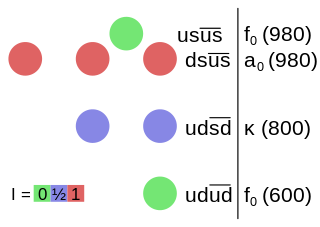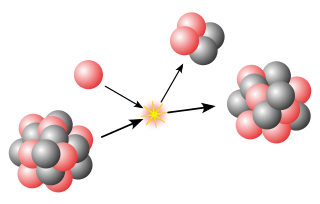Related Research Articles

In particle physics, a baryon is a type of composite subatomic particle that contains an odd number of valence quarks, conventionally three. Protons and neutrons are examples of baryons; because baryons are composed of quarks, they belong to the hadron family of particles. Baryons are also classified as fermions because they have half-integer spin.

Deuterium (hydrogen-2, symbol 2H or D, also known as heavy hydrogen) is one of two stable isotopes of hydrogen; the other is protium, or hydrogen-1, 1H. The deuterium nucleus (deuteron) contains one proton and one neutron, whereas the far more common 1H has no neutrons. Deuterium has a natural abundance in Earth's oceans of about one atom of deuterium in every 6,420 atoms of hydrogen. Thus, deuterium accounts for about 0.0156% by number (0.0312% by mass) of all hydrogen in the ocean: 4.85×1013 tonnes of deuterium – mainly as HOD (or 1HO2H or 1H2HO) and only rarely as D2O (or 2H2O) (Deuterium Oxide, also known as Heavy Water)– in 1.4×1018 tonnes of water. The abundance of 2H changes slightly from one kind of natural water to another (see Vienna Standard Mean Ocean Water).

In particle physics, a meson is a type of hadronic subatomic particle composed of an equal number of quarks and antiquarks, usually one of each, bound together by the strong interaction. Because mesons are composed of quark subparticles, they have a meaningful physical size, a diameter of roughly one femtometre (10−15 m), which is about 0.6 times the size of a proton or neutron. All mesons are unstable, with the longest-lived lasting for only a few tenths of a nanosecond. Heavier mesons decay to lighter mesons and ultimately to stable electrons, neutrinos and photons.

In physics and chemistry, a nucleon is either a proton or a neutron, considered in its role as a component of an atomic nucleus. The number of nucleons in a nucleus defines the atom's mass number.

In nuclear physics and particle physics, the weak interaction, also called the weak force, is one of the four known fundamental interactions, with the others being electromagnetism, the strong interaction, and gravitation. It is the mechanism of interaction between subatomic particles that is responsible for the radioactive decay of atoms: The weak interaction participates in nuclear fission and nuclear fusion. The theory describing its behaviour and effects is sometimes called quantum flavordynamics (QFD); however, the term QFD is rarely used, because the weak force is better understood by electroweak theory (EWT).

The Standard Model of particle physics is the theory describing three of the four known fundamental forces in the universe and classifying all known elementary particles. It was developed in stages throughout the latter half of the 20th century, through the work of many scientists worldwide, with the current formulation being finalized in the mid-1970s upon experimental confirmation of the existence of quarks. Since then, proof of the top quark (1995), the tau neutrino (2000), and the Higgs boson (2012) have added further credence to the Standard Model. In addition, the Standard Model has predicted various properties of weak neutral currents and the W and Z bosons with great accuracy.

In particle physics, a lepton is an elementary particle of half-integer spin that does not undergo strong interactions. Two main classes of leptons exist: charged leptons, including the electron, muon, and tauon, and neutral leptons, better known as neutrinos. Charged leptons can combine with other particles to form various composite particles such as atoms and positronium, while neutrinos rarely interact with anything, and are consequently rarely observed. The best known of all leptons is the electron.
In particle physics, the hyperchargeY of a particle is a quantum number conserved under the strong interaction. The concept of hypercharge provides a single charge operator that accounts for properties of isospin, electric charge, and flavour. The hypercharge is useful to classify hadrons; the similarly named weak hypercharge has an analogous role in the electroweak interaction.
In nuclear physics and particle physics, isospin (I) is a quantum number related to the up- and down quark content of the particle. Isospin is also known as isobaric spin or isotopic spin. Isospin symmetry is a subset of the flavour symmetry seen more broadly in the interactions of baryons and mesons.

In quantum mechanics, a singlet state usually refers to a system in which all electrons are paired. The term 'singlet' originally meant a linked set of particles whose net angular momentum is zero, that is, whose overall spin quantum number . As a result, there is only one spectral line of a singlet state. In contrast, a doublet state contains one unpaired electron and shows splitting of spectral lines into a doublet, and a triplet state has two unpaired electrons and shows threefold splitting of spectral lines.

In particle physics, exotic mesons are mesons that have quantum numbers not possible in the quark model; some proposals for non-standard quark model mesons could be:

In physics, the eightfold way is an organizational scheme for a class of subatomic particles known as hadrons that led to the development of the quark model. Both the American physicist Murray Gell-Mann and the Israeli physicist Yuval Ne'eman independently and simultaneously proposed the idea in 1961. The name comes from Gell-Mann's (1961) paper and is an allusion to the Noble Eightfold Path of Buddhism.
In the Standard Model of electroweak interactions of particle physics, the weak hypercharge is a quantum number relating the electric charge and the third component of weak isospin. It is frequently denoted and corresponds to the gauge symmetry U(1).
In particle physics, weak isospin is a quantum number relating to the electrically charged part of the weak interaction: Particles with half-integer weak isospin can interact with the
W±
bosons; particles with zero weak isospin do not. Weak isospin is a construct parallel to the idea of isospin under the strong interaction. Weak isospin is usually given the symbol T or I, with the third component written as T3 or I3.T3 is more important than T; typically "weak isospin" is used as short form of the proper term "3rd component of weak isospin". It can be understood as the eigenvalue of a charge operator.

The nuclear force is a force that acts between hadrons, most commonly observed between protons and neutrons of atoms. Neutrons and protons, both nucleons, are affected by the nuclear force almost identically. Since protons have charge +1 e, they experience an electric force that tends to push them apart, but at short range the attractive nuclear force is strong enough to overcome the electrostatic force. The nuclear force binds nucleons into atomic nuclei.
In particle physics, isovector refers to the vector transformation of a particle under the SU(2) group of isospin. An isovector state is a triplet state with total isospin 1, with the third component of isospin either 1, 0, or -1, much like a triplet state in the two-particle addition of Spin.
In physics and particularly in particle physics, a multiplet is the state space for 'internal' degrees of freedom of a particle; that is, degrees of freedom associated to a particle itself, as opposed to 'external' degrees of freedom such as the particle's position in space. Examples of such degrees of freedom are the spin state of a particle in quantum mechanics, or the color, isospin and hypercharge state of particles in the Standard Model of particle physics. Formally, we describe this state space by a vector space which carries the action of a group of continuous symmetries.
The eta and eta prime meson are isosinglet mesons made of a mixture of up, down and strange quarks and their antiquarks. The charmed eta meson and bottom eta meson are similar forms of quarkonium; they have the same spin and parity as the (light)
η
defined, but are made of charm quarks and bottom quarks respectively. The top quark is too heavy to form a similar meson, due to its very fast decay.

Jonas Alster is an Israeli nuclear physicist.
Shalom Shlomo is a nuclear physicist, academic, and author. He is a Senior Scientist and Group Leader at the Cyclotron Institute of the Texas A&M University (TAMU).
References
- ↑ Bracco, A.; Lanza, E. G.; Tamii, A. (1 May 2019). "Isoscalar and isovector dipole excitations: Nuclear properties from low-lying states and from the isovector giant dipole resonance". Progress in Particle and Nuclear Physics. 106: 360–433. Bibcode:2019PrPNP.106..360B. doi: 10.1016/j.ppnp.2019.02.001 . hdl: 2434/716331 . ISSN 0146-6410. S2CID 127928945.